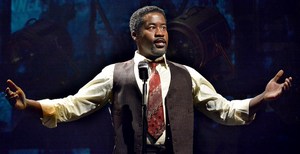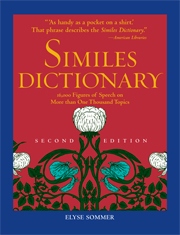SITE GUIDE
SEARCH
REVIEWS
REVIEW ARCHIVES
ADVERTISING AT CURTAINUP
FEATURES
NEWS
Etcetera and
Short Term Listings
LISTINGS
Broadway
Off-Broadway
NYC Restaurants
BOOKS and CDs
OTHER PLACES
Berkshires
London
California
New Jersey
DC
Connecticut
Philadelphia
Elsewhere
QUOTES
TKTS
PLAYWRIGHTS' ALBUMS
LETTERS TO EDITOR
FILM
LINKS
MISCELLANEOUS
Free Updates
Masthead
A CurtainUp DC Review
The Tallest Tree in the Forest
|
I made that song famous and it made me famous.— Paul Robeson, regarding "Old Man River."
|

Daniel Beaty as Paul Robeson (Photo by Dan Ipock)
|
Fortunately, playwright/actor/singer Daniel Beaty ably sustains interest in his alter ego, Paul Robeson. Beaty's one-man show The Tallest Tree in the Forest, a name given to Paul Robeson by civil rights activist and advocate for the education of African-American women Mary McLeod Bethune, is very informative.
The son of a minister and former slave who knew Latin and Greek, Robeson was an educated man of conscience. His singing,wisdom, humanity and politics made him famous all over the world. He was a hero, a civil rights activist and, some might say an idealist — until right wing politics of the House UnAmerican Committee and FBI Director J. Edgar Hoover ruined his career.
Beaty,, beginning with a ten-year old Paul who looks up to his older brother and ending with an old man challenged by bigotry, is very adept at taking on the personae in Robeson's life: his wife (and micro-manager) Essie, the Brits, the Russians, the French, the Harlem Rennaissance crowd and even Mary McLeod Bethune who becomes a running joke until she cuts down "the tallest tree in the forest" because of Robeson's communist sympathies. Some of the impersonations work extremely well – particularly Beaty's take on Essie but others are an embarrassing oversight in Moises Kaufman's otherwise smooth direction. For instance, Beaty makes J. Edgar Hoover sound pseudo-English and the Welsh miner's is … well, it's not Welsh (which might be a good thing.)
The exposition raises some problemmatic questions, such as w whether there really were many people of color in the Soviet Union in the 1930s and whether Robeson was as close to the Russian Jewish intelligentsia as this piece would have you believe? Another question raised is if this a dramatic trope to make the audience compare the anti-semitism in Russia and Europe in the ‘30s and ‘40s to racism in the United States?
The two-hour show (too long by 15 minutes as the second act repeats and repeats themes and facts that have already been presented) has some splendid musical interludes. Beaty has a strong almost operatic voice that is perfect for not just "Ol' Man River" but such varied numbers as "The Joint is Jumpin'," "Happy Days Are Here Again," and a heartfelt "Go Down Moses."
Super-imposed on Derek McLane's already "busy" set, rear-screen projections, which seem to be the go-to device for one-set plays these days, move the action from jazz clubs in Harlem to the miner's strike in London to lynchings in the Southern United States. The mass of striking miners brings home the point that thousands of Welsh and English were seeking a decent wage at the same time African-Americans were trying to better their lot. The silhouettes of lynched bodies hanging from trees are horrible reminders of the United States's shameful history towards Negroes from slavery on. So are the words of J. Edgar Hoover and the HUAC.
Daniel Beaty is a very talented story teller, mimic, and singer. His fascination with Paul Robeson began at least in his undergraduate days at Yale when he performed an earlier version of the show now playing at Arena Stage. As he embodies Robeson we are transported to a time and place different in some ways but not all from our own with plenty to think about along the way.
|
The Tallest Tree in the Forest Written and performed by Daniel Beaty Directed by Moises Kaufman Music Director/Incidental Music and Arrangements by Kenny J. Seymour Set by Derek McLane Lighting by David Lander Cast: Daniel Beaty Running time: two hours with one intermission Arena Stage/Kreeger, 1101 Sixth Street, SW; Washington, DC; www.arenastage.org; tickets $40 to $90; 202-488-3300 January 10 to February 16, 2014. Review by Susan Davidson based on January 16, 2014 performance. REVIEW FEEDBACK Highlight one of the responses below and click "copy" or"CTRL+C"
Curtainup at Facebook . . . Curtainup at Twitter Subscribe to our FREE email updates: E-mail: esommer@curtainup.comesommer@curtainup.com put SUBSCRIBE CURTAINUP EMAIL UPDATE in the subject line and your full name and email address in the body of the message |

|


 Book of Mormon -CD
Book of Mormon -CD